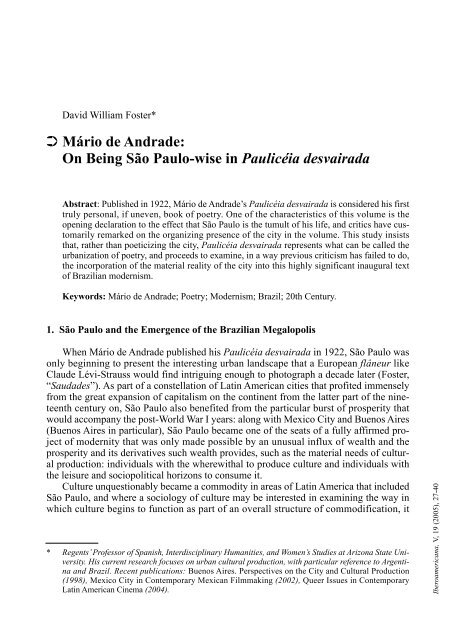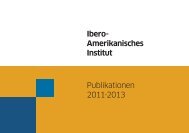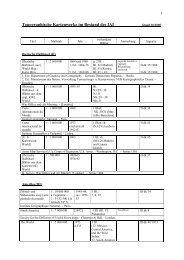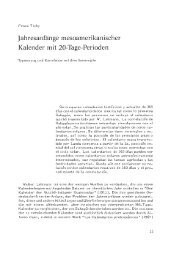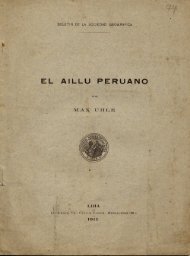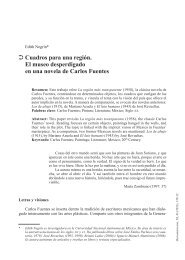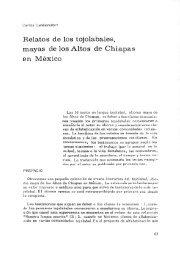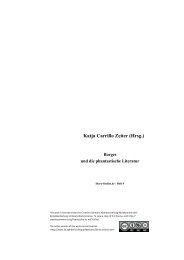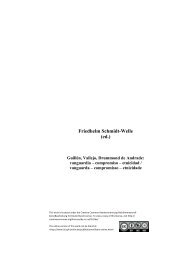Mário de Andrade: On Being São Paulo-wise in Paulicéia desvairada
Mário de Andrade: On Being São Paulo-wise in Paulicéia desvairada
Mário de Andrade: On Being São Paulo-wise in Paulicéia desvairada
Create successful ePaper yourself
Turn your PDF publications into a flip-book with our unique Google optimized e-Paper software.
Rev19-01 22/8/05 13:17 Pág<strong>in</strong>a 27<br />
David William Foster*<br />
➲ <strong>Mário</strong> <strong>de</strong> Andra<strong>de</strong>:<br />
<strong>On</strong> <strong>Be<strong>in</strong>g</strong> <strong>São</strong> <strong>Paulo</strong>-<strong>wise</strong> <strong>in</strong> <strong>Paulicéia</strong> <strong>de</strong>svairada<br />
Abstract: Published <strong>in</strong> 1922, <strong>Mário</strong> <strong>de</strong> Andra<strong>de</strong>’s <strong>Paulicéia</strong> <strong>de</strong>svairada is consi<strong>de</strong>red his first<br />
truly personal, if uneven, book of poetry. <strong>On</strong>e of the characteristics of this volume is the<br />
open<strong>in</strong>g <strong>de</strong>claration to the effect that <strong>São</strong> <strong>Paulo</strong> is the tumult of his life, and critics have customarily<br />
remarked on the organiz<strong>in</strong>g presence of the city <strong>in</strong> the volume. This study <strong>in</strong>sists<br />
that, rather than poeticiz<strong>in</strong>g the city, <strong>Paulicéia</strong> <strong>de</strong>svairada represents what can be called the<br />
urbanization of poetry, and proceeds to exam<strong>in</strong>e, <strong>in</strong> a way previous criticism has failed to do,<br />
the <strong>in</strong>corporation of the material reality of the city <strong>in</strong>to this highly significant <strong>in</strong>augural text<br />
of Brazilian mo<strong>de</strong>rnism.<br />
Keywords: <strong>Mário</strong> <strong>de</strong> Andra<strong>de</strong>; Poetry; Mo<strong>de</strong>rnism; Brazil; 20th Century.<br />
1. <strong>São</strong> <strong>Paulo</strong> and the Emergence of the Brazilian Megalopolis<br />
When <strong>Mário</strong> <strong>de</strong> Andra<strong>de</strong> published his <strong>Paulicéia</strong> <strong>de</strong>svairada <strong>in</strong> 1922, <strong>São</strong> <strong>Paulo</strong> was<br />
only beg<strong>in</strong>n<strong>in</strong>g to present the <strong>in</strong>terest<strong>in</strong>g urban landscape that a European flâneur like<br />
Clau<strong>de</strong> Lévi-Strauss would f<strong>in</strong>d <strong>in</strong>trigu<strong>in</strong>g enough to photograph a <strong>de</strong>ca<strong>de</strong> later (Foster,<br />
“Sauda<strong>de</strong>s”). As part of a constellation of Lat<strong>in</strong> American cities that profited immensely<br />
from the great expansion of capitalism on the cont<strong>in</strong>ent from the latter part of the n<strong>in</strong>eteenth<br />
century on, <strong>São</strong> <strong>Paulo</strong> also benefited from the particular burst of prosperity that<br />
would accompany the post-World War I years: along with Mexico City and Buenos Aires<br />
(Buenos Aires <strong>in</strong> particular), <strong>São</strong> <strong>Paulo</strong> became one of the seats of a fully affirmed project<br />
of mo<strong>de</strong>rnity that was only ma<strong>de</strong> possible by an unusual <strong>in</strong>flux of wealth and the<br />
prosperity and its <strong>de</strong>rivatives such wealth provi<strong>de</strong>s, such as the material needs of cultural<br />
production: <strong>in</strong>dividuals with the wherewithal to produce culture and <strong>in</strong>dividuals with<br />
the leisure and sociopolitical horizons to consume it.<br />
Culture unquestionably became a commodity <strong>in</strong> areas of Lat<strong>in</strong> America that <strong>in</strong>clu<strong>de</strong>d<br />
<strong>São</strong> <strong>Paulo</strong>, and where a sociology of culture may be <strong>in</strong>terested <strong>in</strong> exam<strong>in</strong><strong>in</strong>g the way <strong>in</strong><br />
which culture beg<strong>in</strong>s to function as part of an overall structure of commodification, it<br />
* Regents’Professor of Spanish, Interdiscipl<strong>in</strong>ary Humanities, and Women’s Studies at Arizona State University.<br />
His current research focuses on urban cultural production, with particular reference to Argent<strong>in</strong>a<br />
and Brazil. Recent publications: Buenos Aires. Perspectives on the City and Cultural Production<br />
(1998), Mexico City <strong>in</strong> Contemporary Mexican Filmmak<strong>in</strong>g (2002), Queer Issues <strong>in</strong> Contemporary<br />
Lat<strong>in</strong> American C<strong>in</strong>ema (2004). Iberoamericana, V, 19 (2005), 27-40
Rev19-01 22/8/05 13:17 Pág<strong>in</strong>a 28<br />
28 David William Foster<br />
becomes also of importance to exam<strong>in</strong>e how the materiality of culture also exists as a<br />
thematics of that very cultural production. Certa<strong>in</strong>ly, material aspects of culture are present<br />
<strong>in</strong> the works of Machado <strong>de</strong> Assis a generation before, and, <strong>in</strong><strong>de</strong>ed, Machado’s literature<br />
is significantly un<strong>de</strong>rstood to be possible as a consequence of the very nature of the<br />
society he <strong>de</strong>scribes, with its own high level of prosperity and the preoccupations that<br />
come with and are ma<strong>de</strong> possible by such a socio-economic level (Trigo 2001).<br />
Certa<strong>in</strong>ly Brazilian prosperity is carried to a higher power by post-World War I<br />
<strong>de</strong>velopments, as the economic base shifts (it had actually begun to shift by the early part<br />
of the twentieth century) to <strong>São</strong> <strong>Paulo</strong> and a less feudal and more bourgeois society. It is<br />
the absolutely primum mobile axiom of Brazilian culture that mo<strong>de</strong>rn Brazil has as its<br />
paradigmatic reflex the Semana <strong>de</strong> Arte Mo<strong>de</strong>rna <strong>in</strong> February 1922, an event of which<br />
<strong>Mário</strong> <strong>de</strong> Andra<strong>de</strong> was himself one of the prime movers 1 , and certa<strong>in</strong>ly one dimension of<br />
Andra<strong>de</strong>’s Macunaíma (1928) concerns the other major shift <strong>in</strong> Brazilian society, from<br />
the rural outback (the sertão) to the metropolis. Although Andra<strong>de</strong>’s œuvre manifests<br />
ample <strong>in</strong>terest <strong>in</strong> traditional aspects of Brazilian culture, such as his work on folklore and<br />
traditional music, one of the s<strong>in</strong>gular aspects of Andra<strong>de</strong>’s production dur<strong>in</strong>g the third<br />
<strong>de</strong>ca<strong>de</strong> of the twentieth century is his “discovery” of the city as a realm of human experience<br />
worthy of be<strong>in</strong>g <strong>in</strong>terpreted via poetry. 2<br />
2. The Urbanization of Poetic Language<br />
In<strong>de</strong>ed, it is significant that <strong>Paulicéia</strong> <strong>de</strong>svairada is Andra<strong>de</strong>’s first book of poetry 3,<br />
as though the discovery of the city and the <strong>in</strong>vestment <strong>in</strong> the most privileged form of literary<br />
production, poetry, were to have co<strong>in</strong>ci<strong>de</strong>d. Poetry is, of course, the undisputed<br />
genre of Brazilian mo<strong>de</strong>rnism (as it is of the Lat<strong>in</strong> American equivalent, vanguardismo),<br />
and <strong>in</strong> this case what is of <strong>in</strong>terest is the conjunction of the “unpoetic” texture of the<br />
mo<strong>de</strong>rn metropolis with the privileged Orphean voice. What, then, becomes of <strong>in</strong>terest is<br />
the way <strong>in</strong> which Andra<strong>de</strong> provi<strong>de</strong>s an <strong>in</strong>terpretation of the texture of the dynamically<br />
evolv<strong>in</strong>g <strong>São</strong> <strong>Paulo</strong> of the 1920s: the very title of the collection connotes the nonplacid<br />
nature of its movement. What is not at issue is merely the way <strong>in</strong> which the city is thematized<br />
or “represented” (Perrone 2002), as though the <strong>in</strong>dividual poems (there are<br />
twenty-two <strong>in</strong> all) were pictures <strong>in</strong> an exhibition of landscapes, local-color sett<strong>in</strong>gs, and<br />
typical occupations and pastimes. Rather, of concern are the material aspects of the city<br />
as they become the stuff of poetry: its semiotic processes, rather than its mean<strong>in</strong>g effects;<br />
the urbanization of poetic language, rather than the poetization of the cityscape as Suárez<br />
and Toml<strong>in</strong>s assert (2000: 55).<br />
1 A facsimile of the first edition of <strong>Paulicéia</strong> <strong>de</strong>svairada is to be found <strong>in</strong> Jorge Schwartz’s recent portfolio<br />
of materials relat<strong>in</strong>g to the Semana (2003).<br />
2 Perrone (2002) surveys Andra<strong>de</strong>’s <strong>in</strong>terest <strong>in</strong> <strong>São</strong> <strong>Paulo</strong> and critical estimations of it.<br />
3 Actually, Andra<strong>de</strong> had published Há uma gota <strong>de</strong> sangue em cada poema <strong>in</strong> 1917. However, this volume<br />
is consi<strong>de</strong>red a youthful exercise <strong>in</strong> imitation of the Parnassians and is not <strong>in</strong>clu<strong>de</strong>d, for example,<br />
<strong>in</strong> the edition of Poesias completas [sic] from which I am quot<strong>in</strong>g. The latter, however, appears as vol.<br />
II of the Obras completas <strong>de</strong> <strong>Mário</strong> <strong>de</strong> Andra<strong>de</strong> provi<strong>de</strong>d <strong>in</strong> a list fac<strong>in</strong>g the half-title page; vol. I is<br />
i<strong>de</strong>ntified as Obra imatura, one of whose three components is Há uma gota.
Rev19-01 22/8/05 13:17 Pág<strong>in</strong>a 29<br />
<strong>Mário</strong> <strong>de</strong> Andra<strong>de</strong> 29<br />
In or<strong>de</strong>r to elaborate what might be un<strong>de</strong>rstood by the urbanization of poetic language,<br />
one can beg<strong>in</strong> with the follow<strong>in</strong>g postulates:<br />
1) Such a semiotic process means the <strong>in</strong>corporation <strong>in</strong>to poetry of the fullest parameters<br />
of the city. But whereas, were they to concern themselves with the city at all,<br />
Romantic poetry had engaged <strong>in</strong> pathetic fallacy and Parnassian poetry had i<strong>de</strong>alized the<br />
cityscape <strong>in</strong> terms of Arcadian gar<strong>de</strong>ns and the landscapes of ref<strong>in</strong>ed and privileged<br />
taste, Mo<strong>de</strong>rnism f<strong>in</strong>ds its preferred anchor <strong>in</strong> the city and its evolv<strong>in</strong>g mo<strong>de</strong>rnity. The<br />
very fact that Andra<strong>de</strong> organizes this collection of poems around the city of <strong>São</strong> <strong>Paulo</strong> is<br />
significant. The history of Brazil has been a southward displacement of urban centers,<br />
from the colonial Salvador <strong>de</strong> Bahia to, first, the imperial and, subsequently, the late<br />
n<strong>in</strong>eteenth-century early republican Rio <strong>de</strong> Janeiro, to the <strong>São</strong> <strong>Paulo</strong> that emerges early<br />
<strong>in</strong> the twentieth century as the f<strong>in</strong>ancial center of the country. It is significant to note that<br />
Brasília may now have been the official capital of the country for fifty years. Yet it has<br />
never become anyth<strong>in</strong>g else for the country but a bureaucratic enclave, with none of the<br />
iconic, mythic, or symbolic associations attributed to the three historical centers of the<br />
country. In<strong>de</strong>ed, although one can speak of a filmic production specifically associated<br />
with Rio <strong>de</strong> Janeiro, one is hard-put to recall a major work of poetry like <strong>Paulicéia</strong><br />
<strong>de</strong>svairada <strong>de</strong>voted to Rio or to Bahia. 4 Andra<strong>de</strong>’s poetry is characterized by an emphasis<br />
on the ethos of the city, and on the engagement of the poetic voice with its material<br />
realities: “Tenho os pés chagados nos esp<strong>in</strong>hos das calçadas...” 5 , the open<strong>in</strong>g verse to<br />
“Colloque sentimental” (Andra<strong>de</strong> 1993: 99 6 ).<br />
2) It is <strong>in</strong>evitable that the language referr<strong>in</strong>g to the material reality of the city appears<br />
cited, if not used <strong>in</strong> a poetry on the city. As Andra<strong>de</strong> says <strong>in</strong> one of the affirmations to be<br />
found <strong>in</strong> the “Prefácio <strong>in</strong>teressantíssimo”, a sixty-six paragraph 7 meditation that fronts<br />
<strong>Paulicéia</strong> <strong>de</strong>svairada,<br />
Escrever arte mo<strong>de</strong>rna não significa jamais para mim representar a vida atual no que tem<br />
<strong>de</strong> exterior: automóveis, c<strong>in</strong>ema, asfalto. Si estas palavras freqüentam-me o livro não é porque<br />
pense com elas escrever mo<strong>de</strong>rno, mas porque sendo meu livro mo<strong>de</strong>rno, elas têm nele<br />
sua razão <strong>de</strong> ser (74, paragraph 52).<br />
With such a statement, the difference between the mundane and the lyrical is un<strong>de</strong>rm<strong>in</strong>ed.<br />
Whereas the latter refers to an aesthetic realm removed from the “halluc<strong>in</strong>ations”<br />
of everyday life, the focus on the texture of everyday life of the city – the “<strong>Paulicéia</strong> 8<br />
4 The poetry of Gregório <strong>de</strong> Matos (1636-1696?), as gathered <strong>in</strong> Crônica do viver baiano seiscentista, is<br />
not about the city of Bahia, but rather about human society <strong>in</strong> the context of court life.<br />
5 All ellipses <strong>in</strong> this and subsequent quotes are part of the poetic texts; <strong>in</strong><strong>de</strong>ed, the use of ellipses is <strong>in</strong>tegral<br />
to the “polifonia poética” Andra<strong>de</strong> champions <strong>in</strong> his “Prefácio”, paragraph 36 (Andra<strong>de</strong> 1993: 69).<br />
6 Further page references to poems and l<strong>in</strong>es of poetry are to be un<strong>de</strong>rstood to refer to this edition unless<br />
other<strong>wise</strong> stated.<br />
7 The paragraphs are not numbered <strong>in</strong> the orig<strong>in</strong>al edition nor <strong>in</strong> all critical editions, although they are <strong>in</strong><br />
the one I am cit<strong>in</strong>g from.<br />
8 <strong>Paulicéia</strong> is an alternative, and evi<strong>de</strong>ntly more poetic, name for the city of <strong>São</strong> <strong>Paulo</strong>; it may well be that<br />
Andra<strong>de</strong> uses it here <strong>in</strong> an ironic fashion, s<strong>in</strong>ce he is do<strong>in</strong>g someth<strong>in</strong>g very different <strong>in</strong> his poems than<br />
evok<strong>in</strong>g the poetic images associated with a name such as this.
Rev19-01 22/8/05 13:17 Pág<strong>in</strong>a 30<br />
30 David William Foster<br />
<strong>de</strong>svairada” – br<strong>in</strong>gs with it <strong>in</strong>evitably the specific stylus humilis of the language of<br />
urban existence. 9 The purpose of Andra<strong>de</strong>’s poems would seem not to be to write directly<br />
about the mach<strong>in</strong>ery and <strong>de</strong>vices of mo<strong>de</strong>rn life: he specifically rejects the Futurism of<br />
Mar<strong>in</strong>etti, so associated with “s<strong>in</strong>g<strong>in</strong>g” the mach<strong>in</strong>ery and <strong>de</strong>vices of mo<strong>de</strong>rn life (60,<br />
paragraph 12), but if their appearance is <strong>in</strong>evitable <strong>in</strong> <strong>de</strong>scrib<strong>in</strong>g the cityscape, their<br />
physical presence and their visual and auditory features (their <strong>in</strong>tegral contribution to<br />
urban noise) is <strong>in</strong>escapable.<br />
3) Andra<strong>de</strong>’s commitment to Brazilian Portuguese is legendary (P<strong>in</strong>to 1990). To be<br />
sure, the term “Brazilian Portuguese” means many different th<strong>in</strong>gs and refers to numerous<br />
concurrent <strong>de</strong>velopments of the language as a part of the natural evolution of any<br />
spoken language, especially a <strong>de</strong>territorialized one <strong>in</strong> contact with many other languages<br />
(pre-Conquest <strong>in</strong>digenous languages, the languages of immigrants, and the prestige languages<br />
of alternative cultural mo<strong>de</strong>ls, none of which may be immediately evi<strong>de</strong>nt to the<br />
imperial anchor, past or present); as a part of the pedagogical association with an aca<strong>de</strong>mic<br />
norm (adherence to the imperial norm, but nevertheless conscious of irreversible<br />
local <strong>de</strong>velopments); and as part of the conscious creative projects of literati. Such<br />
<strong>de</strong>velopments may refer as much to the lexicon (which is often what is most un<strong>de</strong>rstood<br />
as the stuff of regional variants), as it does to pronunciation (immediately evi<strong>de</strong>nt, but<br />
often un<strong>de</strong>rrated as literarily significant) and morphosyntax (usually referred to unsystematically).<br />
For example, Andra<strong>de</strong> refers to “A língua brasileira é das mais ricas e sonoras. E<br />
possui o admirabilíssimo ‘ão’” (67, paragraph 34). S<strong>in</strong>ce the diphthong “ão” is not<br />
exclusive to the phonology of Brazilian Portuguese, one won<strong>de</strong>rs whether Andra<strong>de</strong> is<br />
referr<strong>in</strong>g to a certa<strong>in</strong> Brazilian phoneticization, <strong>in</strong> which, rather than a nasalized [a],<br />
what is articulated is a nasalized [ï] 10 . Of course, Andra<strong>de</strong> could simply be referr<strong>in</strong>g to<br />
this phonologic comb<strong>in</strong>ation <strong>in</strong> all dialects of Portuguese, but the nationalism of the<br />
qualifier is noteworthy. There is, throughout the “Prefácio”, a str<strong>in</strong>g of allusions to language.<br />
A particularly allur<strong>in</strong>g one implies a rejection of aca<strong>de</strong>mic standards and a commitment<br />
to the spontaneity of the spoken language, an implied spurn<strong>in</strong>g of the Portuguese<br />
aca<strong>de</strong>mic norm and, <strong>in</strong> the fashion of the Mo<strong>de</strong>rnistas, the bootlegged nature of<br />
national varieties:<br />
A gramática apareceu <strong>de</strong>pois <strong>de</strong> organizadas as línguas. Acontece que meu <strong>in</strong>consciente<br />
não sabe da existência <strong>de</strong> gramáticas, nem <strong>de</strong> línguas organizadas. E como Dom Lirismo é<br />
contrabandista... (73, paragraph 49).<br />
9 See Schell<strong>in</strong>g (1988: 77-79) on Andra<strong>de</strong>’s conceptions of primitivism and language.<br />
10 An articulation that often results <strong>in</strong> the charm<strong>in</strong>g overgeneralization that “Portuguese is just like Romanian”,<br />
s<strong>in</strong>ce the latter is the only other Romance language to have <strong>de</strong>veloped that phone, as is represented<br />
by the circumflexed vowel (an unroun<strong>de</strong>d high back vowel; unroun<strong>de</strong>d [u]) <strong>in</strong> the very name of the<br />
language: rumâno. However, where [ï] is a phoneme <strong>in</strong> Romanian, it is strictly an allophone – stressed<br />
/ã/ <strong>in</strong> contact with follow<strong>in</strong>g unstressed /o/ – <strong>in</strong> Portuguese, a process of regressive dissimilation: the<br />
unround<strong>in</strong>g of /ã/ <strong>in</strong> contact with the follow<strong>in</strong>g roun<strong>de</strong>d /o/, pronounced, <strong>in</strong> any case as [u], s<strong>in</strong>ce progressive<br />
assimilation nasalizes the post-/ã/ vowel, which, s<strong>in</strong>ce it is unstressed is raised from [o] to [u]<br />
(thus, this does not <strong>in</strong>volve progressive assimilation to the high [ï], s<strong>in</strong>ce it would be raised irrespective<br />
of whatever vowel or consonant procee<strong>de</strong>d it). In short, Andra<strong>de</strong> is correct <strong>in</strong> say<strong>in</strong>g that this is a very<br />
dist<strong>in</strong>ctive and, <strong>in</strong><strong>de</strong>ed, complex <strong>de</strong>tail of Brazilian Portuguese phonology.
Rev19-01 22/8/05 13:17 Pág<strong>in</strong>a 31<br />
<strong>Mário</strong> <strong>de</strong> Andra<strong>de</strong> 31<br />
Certa<strong>in</strong>ly, there is a sni<strong>de</strong> remark about Portuguese aca<strong>de</strong>micism conta<strong>in</strong>ed <strong>in</strong> the<br />
follow<strong>in</strong>g affirmation: “Pronomes? Escrevo brasileiro. Si uso ortografia portuguesa é<br />
porque, não alterando o resultado, dá-me uma ortografia (74, paragraph 51).<br />
While Andra<strong>de</strong> does not specifically refer <strong>in</strong> these prefatory notes to the quality of a<br />
geolect typical of mo<strong>de</strong>rn <strong>São</strong> <strong>Paulo</strong>, exist<strong>in</strong>g criticism on <strong>Paulicéia</strong> <strong>de</strong>svairada has<br />
repeatedly observed how its l<strong>in</strong>guistic ca<strong>de</strong>nces constitute an important <strong>in</strong><strong>de</strong>x of the<br />
urban manifestations of Brazilian Portuguese 11 , a phenomenon that could be borne out<br />
by the exam<strong>in</strong>ation of other important literary works of the period anchored <strong>in</strong> <strong>São</strong> <strong>Paulo</strong>,<br />
such as Patrícia Galvão’s Parque <strong>in</strong>dustrial (Jackson 1993; Foster, “The Fem<strong>in</strong>ization”)<br />
or Andra<strong>de</strong>’s Macunaíma. 12<br />
4) <strong>On</strong>e of the overarch<strong>in</strong>g features of <strong>Paulicéia</strong> <strong>de</strong>svairada is its divi<strong>de</strong>d attitu<strong>de</strong> with<br />
regard to the city. <strong>On</strong> the one hand, Andra<strong>de</strong> is unquestionably enthralled by the dynamic<br />
mo<strong>de</strong>rnity of the metropolis, while at the same time he is appalled by the bourgeois vulgarity<br />
that mo<strong>de</strong>rnity enables, as much <strong>in</strong> regard to conventional manners and morality as<br />
the ostentatious theater that is an <strong>in</strong>tegral part of the consumerist imperative of mo<strong>de</strong>rnity.<br />
Thus he is able to enunciate, as the very first verse of the <strong>in</strong>augural poem (“Inspiração”)<br />
of his collection, “<strong>São</strong> <strong>Paulo</strong>! comoção <strong>de</strong> m<strong>in</strong>ha vida...” (83). Yet, two verses later, <strong>in</strong> one<br />
of the recurr<strong>in</strong>g motifs of <strong>Paulicéia</strong> <strong>de</strong>svairada, he refers to “Arlequ<strong>in</strong>al!... Trajes <strong>de</strong><br />
losangos... C<strong>in</strong>za e ouro...” (83). Although other phrases are used with exclamation marks,<br />
“Arlequ<strong>in</strong>al!” is placed as though it were an epiphoneme of “<strong>São</strong> <strong>Paulo</strong>!”, which is repeated<br />
as the penultimate l<strong>in</strong>e of the poem: <strong>São</strong> <strong>Paulo</strong> = Arlequ<strong>in</strong>al! = <strong>São</strong> <strong>Paulo</strong>! References<br />
to arlequ<strong>in</strong>al, either as an adjective or nom<strong>in</strong>alized adjective, abound <strong>in</strong> the collection,<br />
appear<strong>in</strong>g more than a dozen times. 13 Portuguese, like English, allows for this word to<br />
refer to the harlequ<strong>in</strong> both with the specific sense of type of comedic performer, but also<br />
<strong>in</strong> an exten<strong>de</strong>d sense as anyth<strong>in</strong>g that is characterized by the clownish, the buffoonish, the<br />
farcical, with the comedic shad<strong>in</strong>g off <strong>in</strong>to the grotesque.<br />
3. The Bourgeois Megalopolis<br />
Andra<strong>de</strong>’s third poem, “Os cortejos”, states as its fourth verse “Horríveis as<br />
cida<strong>de</strong>s!” (84), while Andra<strong>de</strong>’s acerbic “O<strong>de</strong> ao burguês” is one of the most famous<br />
poems of the collection. It beg<strong>in</strong>s with the verse “Eu <strong>in</strong>sulto o burguês!” (88) and ends<br />
11 Gomes (1979: 27-33), for example, refers to the l<strong>in</strong>gustic orig<strong>in</strong>ality of <strong>Paulicéia</strong> <strong>de</strong>svairada, but like<br />
most critics he <strong>de</strong>votes his attention to the analysis of Macunaíma as present<strong>in</strong>g the best corpus for<br />
un<strong>de</strong>rstand<strong>in</strong>g Andra<strong>de</strong>’s commitment to the “gramatiqu<strong>in</strong>ha da fala brasileira”; see also Proença<br />
(1969). Both are examples of microl<strong>in</strong>guistic analysis – Gomes more grammatical and syntactical features,<br />
Proença more lexical ones; neither, regrettably, gets <strong>in</strong>to issues of l<strong>in</strong>guistic i<strong>de</strong>ology, as does<br />
P<strong>in</strong>to <strong>in</strong> her critical edition of Andra<strong>de</strong>’s A gramatiqu<strong>in</strong>ha. Interest<strong>in</strong>gly enough, she dates the writer’s<br />
<strong>in</strong>terest <strong>in</strong> the elaboration of the Gramatiqu<strong>in</strong>ha from 1922, the same year <strong>in</strong> which <strong>Paulicéia</strong> <strong>de</strong>svairada<br />
was published (P<strong>in</strong>to 1990: 33). The most extensive treatment, however, of the language of <strong>Paulicéia</strong><br />
<strong>de</strong>svairada is Roig’s (1995) very <strong>de</strong>tailed stylistic analysis. Aga<strong>in</strong>, this is more <strong>in</strong> the ve<strong>in</strong> of a microanalysis<br />
of a specific poetic corpus than an essay on l<strong>in</strong>guistic i<strong>de</strong>ology.<br />
12 It is notable that Jack Toml<strong>in</strong>s’ translation of <strong>Paulicéia</strong> <strong>de</strong>svairada <strong>in</strong>to English (Andra<strong>de</strong> 1968) states<br />
that it is “translated from the Brazilian”.<br />
13 See Kossovitch (1990: 94-111) on the importance of this motif <strong>in</strong> Andra<strong>de</strong>’s writ<strong>in</strong>g.
Rev19-01 22/8/05 13:17 Pág<strong>in</strong>a 32<br />
32 David William Foster<br />
with the triple imperative “Fora! Fu! Fora o bom burguês!...” (89). To be sure, one<br />
associates with the city, mo<strong>de</strong>rn or other<strong>wise</strong>, ambivalent attitu<strong>de</strong>s, and the metaphor<br />
of the fall from div<strong>in</strong>e grace <strong>in</strong>stituted by St. August<strong>in</strong>e’s trope of the City of Man is an<br />
abid<strong>in</strong>g figure of Western culture. Jorge Luis Borges, Andra<strong>de</strong>’s contemporary 14 , with<br />
the publication of Fervor <strong>de</strong> Buenos Aires <strong>in</strong> 1923, may have been unst<strong>in</strong>t<strong>in</strong>gly elegiac<br />
<strong>in</strong> his poems to the city of Buenos Aires, but the simple fact is that one associates it<br />
with the evocation of the alternat<strong>in</strong>g pattern of seduction and repulsion that <strong>Paulicéia</strong><br />
<strong>de</strong>svairada ev<strong>in</strong>ces, much <strong>in</strong> the same fashion as other contemporary works like the<br />
Mexico City of Salvador Novo or the New York of Fe<strong>de</strong>rico García Lorca. Not until<br />
the Mexican Carlos Monsiváis’s 1995 Los rituales <strong>de</strong>l caos is the Lat<strong>in</strong> American city<br />
(now more postmo<strong>de</strong>rn or extra-mo<strong>de</strong>rn than mo<strong>de</strong>rn) given its due with the full extent<br />
of its maelstrom-like nature endorsed. Much more customary was the sort of urban<br />
<strong>in</strong>terpretation promoted by the Peruvian Sebastián Salazar Bondy’s 1964 essay Lima<br />
la horrible or the Argent<strong>in</strong>e Ezequiel Martínez Estrada’s 1940 essay La cabeza <strong>de</strong><br />
Goliat.<br />
Richard Morse, <strong>in</strong> his marvelous “biography of <strong>São</strong> <strong>Paulo</strong>”, a subtitle that serves to<br />
grammatically animate the city <strong>in</strong> much the same way that Andra<strong>de</strong> does <strong>in</strong> <strong>Paulicéia</strong>,<br />
writes that<br />
<strong>in</strong> <strong>São</strong> <strong>Paulo</strong>, as <strong>in</strong> the whole Western World, the early years of this century were marked by<br />
childlike exuberance, by naive conceptions of “happ<strong>in</strong>ess” and cultural ref<strong>in</strong>ement, and by<br />
the naive belief that these commodities were <strong>in</strong>evitable rewards for pecuniary success <strong>in</strong> a<br />
world of <strong>in</strong>creas<strong>in</strong>gly numerous and remunerative opportunities. The most vital foreign<br />
<strong>in</strong>fluences were not those <strong>in</strong> which the city passively acquiesced but those which answered its<br />
new rhythms of life (1974: 202-03).<br />
It would now be appropriate to exam<strong>in</strong>e how these primes regard<strong>in</strong>g the urbanization<br />
of a Brazilian poetic voice are carried out <strong>in</strong> representative texts of the two dozen compositions<br />
that make up <strong>Paulicéia</strong> <strong>de</strong>svairada.<br />
To a certa<strong>in</strong> extent, Elizabeth Lowe is correct <strong>in</strong> i<strong>de</strong>ntify<strong>in</strong>g Andra<strong>de</strong>’s “Romantic<br />
pose <strong>in</strong> relation to the city that he embraced and rejected with equal passion” (1982: 94)<br />
– that is, <strong>in</strong>sofar as regards a measure of pathetic fallacy. Lowe does not expla<strong>in</strong> what she<br />
means by a “Romantic pose”, although one suspects that it has to do with the emotional<br />
engagement of the poet with the cityscape, although I would <strong>in</strong>sist that this is not so<br />
much a measure of read<strong>in</strong>g <strong>in</strong>to the city the turbulence of the poet’s own soul, but rather,<br />
<strong>in</strong> a more Whitmanesque way, the manner <strong>in</strong> which the poetic voice engages with the<br />
awesome array of spectacle the city presents (I believe this is the case with DiAntonio’s<br />
(1985) concept of Andradian “pritivism”, a stance often associated with the romantic). If<br />
the recurr<strong>in</strong>g synthetic motif of this spectacle is the Arlequ<strong>in</strong>al, the dazzle of the harlequ<strong>in</strong>’s<br />
outfit and comportment provi<strong>de</strong>s the best cipher of that spectacle. Thus, <strong>in</strong> the follow<strong>in</strong>g<br />
text, “Paisagem No. 1” (there are four), the poetic voice recounts a personalized<br />
engagement with the city:<br />
14 See the comparative study by Rodríguez Monegal (1978).
Rev19-01 22/8/05 13:17 Pág<strong>in</strong>a 33<br />
<strong>Mário</strong> <strong>de</strong> Andra<strong>de</strong> 33<br />
M<strong>in</strong>ha Londres das nebl<strong>in</strong>as f<strong>in</strong>as...<br />
Pleno verão. Os <strong>de</strong>z mil milhões <strong>de</strong> rosas paulistanas.<br />
Há neves <strong>de</strong> perfumes no ar.<br />
Faz frio, muito frio...<br />
E a ironia das pernas das costureir<strong>in</strong>has<br />
Parecidas com bailar<strong>in</strong>as...<br />
O vento é como uma navalha<br />
Nas mãos dum espanhol. Arlequ<strong>in</strong>al...<br />
Há duas horas queimou Sol.<br />
Daqui a duas horas queima Sol.<br />
Passa um <strong>São</strong> Bobo, cantando, sob os plátanos,<br />
Um tralalá... A guarda-cívica! Prisão!<br />
Necessida<strong>de</strong> a prisão<br />
Para que haja civilização?<br />
Meu coração sente-se muito triste...<br />
Enquanto o c<strong>in</strong>zento das ruas arrepiadas<br />
Dialoga um lamento como o vento...<br />
Meu coração sente-se muito alegre!<br />
Este frioz<strong>in</strong>ho arrebitado<br />
Dá uma vonta<strong>de</strong> <strong>de</strong> sorrir!<br />
E sigo. E vou sent<strong>in</strong>do,<br />
À <strong>in</strong>quieta alacrida<strong>de</strong> da <strong>in</strong>vernia,<br />
Como um gosto <strong>de</strong> lágrimas na boca... (87-88)<br />
There is an <strong>in</strong>ternal contradiction between the first and the second verses: while it is<br />
certa<strong>in</strong>ly un<strong>de</strong>rstandable for the poet to see <strong>São</strong> <strong>Paulo</strong> as a version of foggy London, and<br />
a London that is anchored <strong>in</strong> the tight personal relationship implied by the possessive<br />
adjective, the second verse refers to the fact that what he is contemplat<strong>in</strong>g is characteristic<br />
of the middle of summer. I would suggest that what is go<strong>in</strong>g on here is that the middle<br />
of the summer <strong>in</strong> <strong>São</strong> <strong>Paulo</strong> (January and February) is the middle of w<strong>in</strong>ter <strong>in</strong> England,<br />
the period, of course, of the <strong>de</strong>ep fogs of London (at least before current air pollution<br />
controls). So that what the poet perceives is that the <strong>São</strong> <strong>Paulo</strong> summer, with its comb<strong>in</strong>ation<br />
of temperatures averag<strong>in</strong>g <strong>in</strong> the mid-90s and its equally high <strong>in</strong><strong>de</strong>x of humidity,<br />
produces a shimmer<strong>in</strong>g atmosphere as though it were the equivalent of the fabled London<br />
fog. Thus, the air perfumed by the semitropical vegetation that is one of the city’s<br />
hallmarks (particularly evi<strong>de</strong>nt <strong>in</strong> downtown green spaces such as the Praça da República<br />
and the Parque Trianon [officially, Parque Siqueira Campos]), not to mention the<br />
many other impressive parks and green spaces the city has to offer) is as though replete<br />
with flocks of snow, and, as a consequence, that air is cold, very cold.<br />
This long <strong>in</strong>troductory stanza pursues the image of, to <strong>in</strong>dulge directly <strong>in</strong> an oxymoron,<br />
a tropical cold with the conceit of that cold cutt<strong>in</strong>g like a straight razor <strong>in</strong> the<br />
hands of a Spaniard. The moment of contemplation is a period between the sun of two<br />
hours ago and the sun of two hours hence, as though this were a customary <strong>in</strong>terlu<strong>de</strong> <strong>in</strong><br />
the heat of the day <strong>in</strong> which the temperature somehow dropped, which would produce an<br />
<strong>in</strong>verse climatological bell curve (s<strong>in</strong>ce a natural one would be cool morn<strong>in</strong>gs, followed
Rev19-01 22/8/05 13:17 Pág<strong>in</strong>a 34<br />
34 David William Foster<br />
by the heat of the day, followed by cool even<strong>in</strong>gs). The image of the legs of the dress<br />
shop girls (marked by poverty, malnourished, and rachitic) seem<strong>in</strong>g ironically to be<br />
those of bailar<strong>in</strong>as re<strong>in</strong>forces the transformative gaze here – a gaze <strong>in</strong> which the texture<br />
of the city dur<strong>in</strong>g the summer imposes a transformation as though one were see<strong>in</strong>g w<strong>in</strong>ter<br />
– because the mundane transit of the shop workers were like the graceful transit<br />
across the landscape of the highly tra<strong>in</strong>ed dancer. Overall, there is a transformative perception<br />
here <strong>in</strong> favor of a highly erratic poetization of the cityscape.<br />
4. Urban Life Ma<strong>de</strong> Poetic<br />
Yet I have <strong>in</strong>sisted that the tenor of <strong>Paulicéia</strong> <strong>de</strong>svairada is not the poeticization of<br />
the urban sett<strong>in</strong>g, but rather the <strong>in</strong>corporation <strong>in</strong>to a poetic discourse of the texture of<br />
urban life. Thus, <strong>in</strong> the follow<strong>in</strong>g three stanzas, the material reality of the city <strong>in</strong>tru<strong>de</strong>s on<br />
this poetic vision 15 , driven by the metamorphosis of the poet’s <strong>São</strong> <strong>Paulo</strong> <strong>in</strong> the summertime<br />
<strong>in</strong>to the topos of foggy London <strong>in</strong> the w<strong>in</strong>ter, to specify some of its less “poetic” circumstances.<br />
These <strong>in</strong>clu<strong>de</strong> the “<strong>São</strong> Bobo”, an example of the roam<strong>in</strong>g urban crazies,<br />
s<strong>in</strong>g<strong>in</strong>g to himself un<strong>de</strong>r the ever-present canopy of the banana trees, an <strong>in</strong>tegral part of<br />
the city’s landscap<strong>in</strong>g and a form of natural sha<strong>de</strong> for a street person who has no hope of<br />
any other sort of protection from the sun; and the presence of the city police, whose presence<br />
is a rem<strong>in</strong><strong>de</strong>r of the specter of imprisonment for the disor<strong>de</strong>rly, an imprisonment<br />
necessary <strong>in</strong> or<strong>de</strong>r to preserve the civilization of which the city is a paradigm. 16 Such<br />
images reaffirm the perception of w<strong>in</strong>try cold, but it is clearly more of an emotional chill<br />
than a meteorological one, as a dialogue between the grimness of the cityscape (the perfumed<br />
flocks have been forgotten) and the w<strong>in</strong>d of social reality engage <strong>in</strong> a dialogue of<br />
lament. Andra<strong>de</strong>’s stanza is not itself a lament, s<strong>in</strong>ce it evokes a mood rather than articulat<strong>in</strong>g<br />
a response to that mood, but it is metapoetic <strong>in</strong> the sense of juxtapos<strong>in</strong>g the discourse<br />
of the poem to that articulated by the streets themselves: the literary poem cites,<br />
so to speak, the material poem of the now <strong>de</strong>ci<strong>de</strong>dly unpoetic streets. That is, the lyricism<br />
of the open<strong>in</strong>g stanza now must engage implicitly <strong>in</strong> an antiphony with the <strong>de</strong>tails<br />
of social reality, which cannot be evoked jejunely by poetic tropes. Whereas the social<br />
reality of the proletarian shop girls poeticized them as bailar<strong>in</strong>as, noth<strong>in</strong>g rema<strong>in</strong>s here<br />
to poetize: not urban crazies, not the city police with their rem<strong>in</strong><strong>de</strong>r of the consequences<br />
civilization imposes on disor<strong>de</strong>rl<strong>in</strong>ess, not the (presumedly) ragged banana trees (hardly<br />
the spread<strong>in</strong>g chestnut/elm/oak trees that provi<strong>de</strong> sha<strong>de</strong> <strong>in</strong> a topical Arcadian landscape),<br />
and certa<strong>in</strong>ly not the shiver<strong>in</strong>g grayness of the w<strong>in</strong>d-swept streets.<br />
The second stanza implies a mood sw<strong>in</strong>g (verse fifteen, “Meu coração sente-se muito<br />
triste...”, becomes verse eighteen, “Meu coração sente-se muito alegre!”): the ellipses of<br />
15 Lima <strong>in</strong>sists that Andra<strong>de</strong>’s poetry is characterized by the “anonimato da subjectivida<strong>de</strong>” (1968: 43). It<br />
is un<strong>de</strong>niable that the poet’s vision of <strong>São</strong> <strong>Paulo</strong> <strong>in</strong> <strong>Paulicéia</strong> <strong>de</strong>svairada is markedly subjective, but this<br />
does not attenuate the often very specific material presence of the city <strong>in</strong> the collection.<br />
16 <strong>São</strong> <strong>Paulo</strong> <strong>in</strong> the 1920s was undoubtedly more beset by problems of disor<strong>de</strong>rl<strong>in</strong>ess, <strong>in</strong>clud<strong>in</strong>g specifically<br />
those that accompanied rapid growth based <strong>in</strong> large measure on the <strong>in</strong>flux from both abroad and from<br />
the <strong>in</strong>terior, than <strong>São</strong> <strong>Paulo</strong> of recent <strong>de</strong>ca<strong>de</strong>s <strong>in</strong> which violent crime is a permanent part of the city’s<br />
fabric; on violence <strong>in</strong> <strong>São</strong> <strong>Paulo</strong> <strong>in</strong> the twentieth century, see Cal<strong>de</strong>ra (2000).
Rev19-01 22/8/05 13:17 Pág<strong>in</strong>a 35<br />
<strong>Mário</strong> <strong>de</strong> Andra<strong>de</strong> 35<br />
verse fifteen are someth<strong>in</strong>g like the orthographic antonym of the exclamation po<strong>in</strong>t of<br />
verse eighteen, which, <strong>in</strong> addition to the explicit movement from “triste” to “alegre”, is<br />
susta<strong>in</strong>ed by the pair<strong>in</strong>g of the partially phonetically similar “arrepiadas” (verse sixteen)<br />
and “arrebitado” (verse n<strong>in</strong>eteen). Such a mood sw<strong>in</strong>g is <strong>in</strong>dicative of Andra<strong>de</strong>’s profoundly<br />
mixed feel<strong>in</strong>gs about the city of <strong>São</strong> <strong>Paulo</strong>, the <strong>in</strong>terplay of embrace and rejection<br />
Lowe (1982) refers to. 17 Of course, if I may be subjective, a certa<strong>in</strong> amount of cold<br />
does lift the spirits <strong>in</strong> the face of the oppressive realities of the city. But no further elaboration<br />
is given, and the poem conclu<strong>de</strong>s with the stanza <strong>in</strong>augurated by the pithy <strong>de</strong>clarative<br />
“E sigo”, because this is the poet’s relation to the city: a cont<strong>in</strong>u<strong>in</strong>g to traverse it, a<br />
cont<strong>in</strong>u<strong>in</strong>g to perceive it, a cont<strong>in</strong>u<strong>in</strong>g to feel the emotions of attraction and repulsion it<br />
produces. What is notable is that whatever it is that he has synthesized about the city as a<br />
w<strong>in</strong>try gloom, it leaves a taste of sadness <strong>in</strong> his mouth, and that is the clos<strong>in</strong>g image of<br />
the poem: urban reality is always more wont to produce a sensation of sadness than happ<strong>in</strong>ess.<br />
Neither an i<strong>de</strong>alized landscape nor one of disillusionment, neither utopian nor<br />
dystopian, Andra<strong>de</strong>’s <strong>São</strong> <strong>Paulo</strong> is always the mixed image of the harlequ<strong>in</strong>: panache<br />
signall<strong>in</strong>g grotesque farce.<br />
The open<strong>in</strong>g l<strong>in</strong>e of “Colloque sentimental” might serve as a hypogram for the totality<br />
of <strong>Paulicéia</strong> <strong>de</strong>svairada:<br />
Tenho os pés chagados nos esp<strong>in</strong>hos das calçadas...<br />
Higienópolis!... As Babilônias dos meus <strong>de</strong>sejos baixos...<br />
Casas nobres <strong>de</strong> estilo... Enriqueceres em tragédias...<br />
Mas a noite é toda um véu-<strong>de</strong>-noiva ao luar!<br />
A preamar dos brilhos das mansões...<br />
O jazz-band da cor... O arco-íris dos perfumes...<br />
O clamor dos cofres abarrotados <strong>de</strong> vidas...<br />
Ombros nus, ombros nus, lábios pesados <strong>de</strong> adultério...<br />
E o rouge – cogumelo das podridões...<br />
Exércitos <strong>de</strong> casacas eruditamente bem talhadas...<br />
Sem crimes, sem roubos o carnaval dos títulos...<br />
Si não fosse o talco a<strong>de</strong>us sacos <strong>de</strong> far<strong>in</strong>ha!<br />
Impiedosamente...<br />
–Cavalheiro... –Sou con<strong>de</strong>! –Perdão.<br />
Sabe que existe um Brás, um Bom Retiro?<br />
–Apre! respiro... Pensei que era pedido.<br />
Só conheço Paris!<br />
–Venha comigo então.<br />
Esqueça um pouco os braços da viz<strong>in</strong>ha...<br />
–Percebeu, he<strong>in</strong>! Dou-lhe gorgeta e cale-se.<br />
O sultão tem <strong>de</strong>z mil... Mas eu sou con<strong>de</strong>!<br />
17 There is much that is schematic <strong>in</strong> Andra<strong>de</strong>’s poems; see Foster (1965).
Rev19-01 22/8/05 13:17 Pág<strong>in</strong>a 36<br />
36 David William Foster<br />
5. The Poetic I and the City<br />
–Vê? Estas paragens trevas <strong>de</strong> silêncio...<br />
Nada <strong>de</strong> asas, nada <strong>de</strong> alegria... A Lua...<br />
A rua toda nua... As casas sem luzes...<br />
E a mirra dos martírios <strong>in</strong>conscientes...<br />
–Deixe-me por o lenço no nariz.<br />
Tenho todos os perfumes <strong>de</strong> Paris!<br />
–Mas olhe, em baixo das portas, a escorrer...<br />
–Para os esgotos! Para os esgotos!<br />
–...a escorrer,<br />
Um fio <strong>de</strong> lágrimas seu nome! (99-100).<br />
A “hypogram”, as <strong>de</strong>veloped by Riffaterre, is often un<strong>de</strong>rstood to be the title of a<br />
poem, an abstract of what perception of mean<strong>in</strong>g or sentiment it will <strong>de</strong>velop. “Colloque<br />
sentimental” certa<strong>in</strong>ly functions appropriately <strong>in</strong> this regard, announc<strong>in</strong>g that the poem<br />
is constructed around a conversation that br<strong>in</strong>gs out a range of feel<strong>in</strong>gs – <strong>in</strong> this case,<br />
contrary ones about the city, <strong>in</strong> l<strong>in</strong>e with the general stance taken by the poetic I <strong>in</strong><br />
<strong>Paulicéia</strong> <strong>de</strong>svairada. However, the hypogram of a poem may be one of its key verses,<br />
typically its open one, which serve as sort of a “thesis statement” (<strong>in</strong> the case of untitled<br />
poems, of course, it is common to give as their title, if solely for purposes of <strong>in</strong><strong>de</strong>x<strong>in</strong>g,<br />
the first l<strong>in</strong>e). In this case, however, the open<strong>in</strong>g l<strong>in</strong>e of “Colloque sentimental” is not so<br />
much a hypogram of this one poem, as it is of the entire body of two dozen compositions.<br />
This is so for the follow<strong>in</strong>g reasons.<br />
First of all, it echoes for the poem the overall anchor<strong>in</strong>g of <strong>Paulicéia</strong> <strong>de</strong>svairada <strong>in</strong><br />
the role of the poetic I as a poetic eye (I mean to make noth<strong>in</strong>g of the fact that <strong>in</strong> English<br />
these are homonyms). Throughout, the poet is an observer engaged <strong>in</strong> scrut<strong>in</strong>iz<strong>in</strong>g, often<br />
at consi<strong>de</strong>rable emotional cost (and, here, physical cost) the burgeon<strong>in</strong>g city at a time<br />
when <strong>São</strong> <strong>Paulo</strong> is un<strong>de</strong>rgo<strong>in</strong>g the transformation from the center for the plantation economy<br />
of the state of <strong>São</strong> <strong>Paulo</strong> <strong>in</strong>to a mo<strong>de</strong>rn <strong>in</strong>dustrial center, which <strong>in</strong> turn will serve as<br />
the spr<strong>in</strong>gboard for the city’s emergence as the f<strong>in</strong>ancial capital of the entire cont<strong>in</strong>ent.<br />
The poetic I as <strong>in</strong>quisitive eye will scrut<strong>in</strong>ize the contrast between the ol<strong>de</strong>r seignorial<br />
city and a metropolis team<strong>in</strong>g with proletarian workers, <strong>in</strong>clud<strong>in</strong>g immigrant masses;<br />
between the rawness of the texture of this evolv<strong>in</strong>g urban scene and the paradigmatic<br />
image of Paris (which was as much a mo<strong>de</strong>l to the old plantation aristocracy as it was to<br />
the new vanguard generation); between the mo<strong>de</strong>rn exemplars of Paulistana life and the<br />
motif of Babylonian excess and <strong>de</strong>ca<strong>de</strong>nce.<br />
Second, the poet is an <strong>in</strong>carnation of the homo viator, the <strong>in</strong>dividual who roams the<br />
world and reports on what is to be perceived. Certa<strong>in</strong>ly, the topos of the homo viator is<br />
customarily l<strong>in</strong>ked with the motif of the journey of life, and it is often embed<strong>de</strong>d <strong>in</strong> a Bildungsroman<br />
as the major <strong>de</strong>vice for generat<strong>in</strong>g the experiences that lead to the protagonist’s<br />
character formation (as such, Andra<strong>de</strong>’s Macunaíma is very much a parody of the
Rev19-01 22/8/05 13:17 Pág<strong>in</strong>a 37<br />
<strong>Mário</strong> <strong>de</strong> Andra<strong>de</strong> 37<br />
mo<strong>de</strong>rn Bildungsroman). However, the homo viator is a potent poetic trope that captures<br />
one process for contemplat<strong>in</strong>g the world and thereby produc<strong>in</strong>g a perception that validates<br />
the poetic effort. It is the experience, as the open<strong>in</strong>g l<strong>in</strong>e of a traditional Englishlanguage<br />
Christmas carol has it, of the <strong>in</strong>dividual who can say “I won<strong>de</strong>r as I wan<strong>de</strong>r out<br />
un<strong>de</strong>r the sky”. In this case, there is not an explicit reference to see<strong>in</strong>g, but there is to<br />
wan<strong>de</strong>r<strong>in</strong>g, as the Belle Époque flâneur has been replaced by the <strong>in</strong>dividual who breaks<br />
free of the former’s limited prestige circuit – to cont<strong>in</strong>ue the conjunction with the image<br />
of Paris, the Walter Benjam<strong>in</strong> upper-bourgeois realm of the arca<strong>de</strong>, often transformed <strong>in</strong><br />
a balmier Lat<strong>in</strong> America <strong>in</strong>to the pe<strong>de</strong>strian mall of which the aristocratic Buenos Aires<br />
Calle Florida of yore is the paradigm (Cócaro/Cócaro 1984) – to, literally, stumble<br />
through the streets.<br />
The way <strong>in</strong> which the poet stumbles through the material reality of the streets, literally<br />
wound<strong>in</strong>g his feet on their rough edges (this is one of the f<strong>in</strong>est images <strong>in</strong> all of Lat<strong>in</strong><br />
American poetry as it refers to an <strong>in</strong>teraction with the physical city), is carried out <strong>in</strong> the<br />
paired elements that make the poem a colloquy, <strong>in</strong> the basic sense of the word, as, for<br />
example, <strong>in</strong> the contrast between the hustle and bustle of popular <strong>São</strong> <strong>Paulo</strong> neighborhoods<br />
(Brás, Bom Retiro) and Paris, by which one un<strong>de</strong>rstands not all of Paris (which,<br />
on this level, would certa<strong>in</strong>ly present no fewer examples of the rough edges of urban life<br />
than would <strong>São</strong> <strong>Paulo</strong>, and <strong>in</strong><strong>de</strong>ed, because of its age, even more), but the Paris of the<br />
patrician image of privilege, elegance, and or<strong>de</strong>rl<strong>in</strong>ess (as <strong>in</strong> Higonnet 2002). By contrast,<br />
if the term “Paris” refers to the realm of the flâneur and congeners and <strong>de</strong>scendants,<br />
“<strong>São</strong> <strong>Paulo</strong>” is synonymous with popular areas such as Brás, the paradigm of the<br />
<strong>in</strong>dustrial districts to the east of the central core (the Praça da Sé), and Bom Retiro, the<br />
Jewish quarter to the north anchored by the Parque da Luz and its tra<strong>in</strong> station, which is,<br />
to use an American metaphor of team<strong>in</strong>g throngs, the Grand Central Station of the city<br />
(Diaféria et al. 2001).<br />
Another contrast<strong>in</strong>g element functions along the same l<strong>in</strong>es: the dra<strong>in</strong>s (presumably<br />
fetid) of the city and the handkerchief sweetened with French perfumes the “count”<br />
holds to his nose aga<strong>in</strong>st the urban fragrances. In<strong>de</strong>ed, it is reasonable to believe that the<br />
“count” here, who is given a tour through some areas of the city (“Venha comigo então”),<br />
is not a French visitor, but rather an example of the (often pseudo-) upper-class <strong>in</strong>dividual,<br />
still cl<strong>in</strong>g<strong>in</strong>g to what rema<strong>in</strong>s of the pre-Republic aristocracy (whose sway was not<br />
that long ago, as the Republic dates from 1889, and Andra<strong>de</strong>’s book from 1922), whose<br />
po<strong>in</strong>t of reference is elegant Higienópolis, but who has <strong>de</strong>scen<strong>de</strong>d to the urban Babylon<br />
to enjoy the company of a prostitute (“Esqueça um pouco os braços da viz<strong>in</strong>ha...”). The<br />
poetic I here presumably equates himself with that of the prostitute, s<strong>in</strong>ce “viz<strong>in</strong>ha” must<br />
belong to the <strong>de</strong>ictic sphere of the speaker and not that of the client (note that Higienópolis<br />
is, <strong>in</strong> reality, a major avenue and not a district, although the name is often used as<br />
such, to evoke part of the prosperous neighborhood of Consolação, to the west of the<br />
central core – that is, on the other si<strong>de</strong> from the <strong>in</strong>dustrial area evoked by the reference to<br />
Brás; the very name Higienópolis, of course, po<strong>in</strong>ts to how this part of the city is reputedly<br />
healthier than the fetid realms to the east, and elsewhere Andra<strong>de</strong> will refer to the<br />
Jard<strong>in</strong>s, a large and very prosperous area to the South-Southeast of Consolação and south<br />
of the central core).<br />
F<strong>in</strong>ally, the synecdoche of the material reality on which the poetic I wounds his feet<br />
are the paved streets of the city. <strong>On</strong>e could certa<strong>in</strong>ly wound oneself and endanger one’s
Rev19-01 22/8/05 13:17 Pág<strong>in</strong>a 38<br />
38 David William Foster<br />
health on the mud tracks of a forgotten village, but here specific mention is ma<strong>de</strong> of one<br />
of the s<strong>in</strong>gular characteristics of the built environment of the urban landscape, the paved<br />
street, although such an improvement for transportation is not without its problematical<br />
aspects, and such <strong>in</strong>stallations are rarely kept up, <strong>in</strong> the sprawl<strong>in</strong>g environment of the<br />
Lat<strong>in</strong> American megalopolis, <strong>in</strong> optimum conditions. There are often potholes and open<br />
trenches that have been there for so long that they veritably <strong>de</strong>serve a bronze plaque as<br />
national monuments to the problems of ma<strong>in</strong>ta<strong>in</strong><strong>in</strong>g the <strong>in</strong>frastructure of the city. Another<br />
<strong>de</strong>tail of the problematical <strong>in</strong>frastructure of the city is that of stand<strong>in</strong>g or trickl<strong>in</strong>g fetid<br />
water, an example of the imperfectly or <strong>in</strong>completely channeled waste that is as much<br />
that of the occupants of the city as it is of the <strong>in</strong>stallations of their built environment (that<br />
is, as much a problem of leak<strong>in</strong>g “used” or “black” water as it is of leak<strong>in</strong>g <strong>in</strong>com<strong>in</strong>g<br />
“white” water that often becomes contam<strong>in</strong>ated by the construction substances of build<strong>in</strong>gs).<br />
Andra<strong>de</strong> here uses that water as a metaphor for the nameless tears of the occupants<br />
of neighborhoods of the unfortunate <strong>in</strong>to which the “count” has ventured: “Estas paragens<br />
trevas <strong>de</strong> silêncio...”<br />
The sentimentality to which “Colloque sentimental” refers is hardly of the sublime<br />
or<strong>de</strong>r of Romantic poetry – if I may once aga<strong>in</strong> restrict the characterization Lowe (1982)<br />
makes of Pauliçeia <strong>de</strong>svairada – but rather the impressionistic reactions of the poetic I<br />
to the features of the city that wound him both emotionally and physically. <strong>On</strong>ce aga<strong>in</strong>,<br />
the material reality of the cityscape, the “cogumelo das podridões”, is imported <strong>in</strong>to the<br />
discourse of poetry as part of the urbanization of its semiotic dynamics. <strong>Paulicéia</strong><br />
<strong>de</strong>svairada is hardly a hymn or an o<strong>de</strong> to the city. If mo<strong>de</strong>rn <strong>São</strong> <strong>Paulo</strong>/<strong>São</strong> <strong>Paulo</strong> of an<br />
emerg<strong>in</strong>g high mo<strong>de</strong>rnity is the realm of the bourgeois triumphant – “A digestão bem<br />
feita <strong>de</strong> <strong>São</strong> <strong>Paulo</strong>!” (“O<strong>de</strong> ao burguês”, 88) –, the poet can neither simply s<strong>in</strong>g its accomplishments,<br />
as Walt Whitman did <strong>in</strong> the case of New York, or <strong>de</strong>nounce its <strong>de</strong>predations,<br />
as – to cont<strong>in</strong>ue the example of New York – Fe<strong>de</strong>rico García Lorca was to do less than a<br />
<strong>de</strong>ca<strong>de</strong> later with Poeta en Nueva York. Andra<strong>de</strong> is manifestly <strong>in</strong>terested <strong>in</strong> the city of<br />
<strong>São</strong> <strong>Paulo</strong> as a complex human space, and not merely a forum for project<strong>in</strong>g one or<br />
another social <strong>in</strong>terpretation. That this is manifest may be un<strong>de</strong>rstood with the many<br />
ways <strong>in</strong> which he focuses on fundamental aspects of the city that occasion as much the<br />
joy of their vitality as the <strong>de</strong>spair of their ugl<strong>in</strong>ess, “Esse espectáculo encantado da<br />
Avenida” (“O domador”, 92 [the reference is to the Avenida Paulista, the ma<strong>in</strong> f<strong>in</strong>ancial<br />
corridor of the city]) vs. “Formigueiro on<strong>de</strong> todos se mor<strong>de</strong>m e <strong>de</strong>voram” (“A caçada”,<br />
94). The f<strong>in</strong>al verse of the clos<strong>in</strong>g poem of <strong>Paulicéia</strong> <strong>de</strong>svairada serves as a summary<br />
statement to Andra<strong>de</strong>’s ambiguous poetic <strong>in</strong>teraction with the city: “Oh! este orgulho<br />
máximo <strong>de</strong> ser paulistamente!!!” (“Paisagem No. 4”, 102). 18<br />
Asi<strong>de</strong> from the triple exclamation po<strong>in</strong>t, a rhetorical <strong>in</strong>sistence not found elsewhere<br />
<strong>in</strong> the collection, what is notable about this verse is the grammatical solecism it <strong>in</strong>volves,<br />
18 Actually, “Paisagem No. 4” is not the last text <strong>in</strong> <strong>Paulicéia</strong> <strong>de</strong>svairada, although it is the last free-stand<strong>in</strong>g<br />
poem, at least <strong>in</strong> the conventional sense of poetry. The volume closes with 254 verses of short poems<br />
represent<strong>in</strong>g diverse Paulista voices, framed by prose statements, all constitut<strong>in</strong>g “As enfibraturas do Ipiranga<br />
(oratorio profano)”. The sett<strong>in</strong>g for this oratory is the esplana<strong>de</strong> of the Teatro Municipal, which is<br />
where the Semana <strong>de</strong> Arte Mo<strong>de</strong>rna took place <strong>in</strong> February 1922. Avenida Ipiranga is a major avenue that<br />
passes along the south si<strong>de</strong> of the Praça da República, a few blocks away from the Teatro Municipal. See<br />
Nunes (1984) on this composition as emblematic of the Semana <strong>de</strong> Arte Mo<strong>de</strong>rna.
Rev19-01 22/8/05 13:17 Pág<strong>in</strong>a 39<br />
<strong>Mário</strong> <strong>de</strong> Andra<strong>de</strong> 39<br />
a solecism that bears the poet’s f<strong>in</strong>al statement. The po<strong>in</strong>t is that this verse does not<br />
close with a nom<strong>in</strong>al or adjectival predicate, the grammatical accompaniments of the<br />
verb “ser”, but rather with an adverbial complement. Adverbial complements may grammatically<br />
be used with the other essive verb <strong>in</strong> Portuguese, “estar” (which may also take<br />
an adverbial complement, but not grammatically a nom<strong>in</strong>al one), and such a construction<br />
expresses the status of, <strong>in</strong> terms of manner or mo<strong>de</strong>, the subject at a particular<br />
moment. However, by us<strong>in</strong>g an adverb with “ser”, the poetic I affirms, as grammar<br />
books usually expla<strong>in</strong> it, the “permanent and on-go<strong>in</strong>g quality” of the subject of the<br />
predicate. Jack Toml<strong>in</strong>s, <strong>in</strong> his translation of <strong>Paulicéia</strong> <strong>de</strong>svairada, <strong>in</strong> the face of how to<br />
ren<strong>de</strong>r such a solecism <strong>in</strong>to English, opts for “Oh! this supreme pri<strong>de</strong> <strong>in</strong> exist<strong>in</strong>g <strong>São</strong><br />
<strong>Paulo</strong>-<strong>wise</strong>!!!” (Andra<strong>de</strong> 1968: 75), although the adverbial marker of the complement is<br />
lost (-ish function<strong>in</strong>g <strong>in</strong> English to mark adjectives). I will not venture to try to improve<br />
on Toml<strong>in</strong>s’ translation, s<strong>in</strong>ce captur<strong>in</strong>g solecisms <strong>in</strong> translation is a particular stylistic<br />
challenge. Suffice it to say that Andra<strong>de</strong>’s clos<strong>in</strong>g trope is fully characteristic of the way<br />
<strong>in</strong> which he has written about <strong>São</strong> <strong>Paulo</strong>, transmitt<strong>in</strong>g both his ambiguous feel<strong>in</strong>gs and<br />
succeed<strong>in</strong>g admirably <strong>in</strong> convert<strong>in</strong>g a complex mo<strong>de</strong>rn urbanscape <strong>in</strong>to the l<strong>in</strong>guistic<br />
event of poetry.<br />
References<br />
Andra<strong>de</strong>, <strong>Mário</strong> <strong>de</strong> (1968): Halluc<strong>in</strong>ated City. Paulicea <strong>de</strong>svairada. Translated from the Brazilian<br />
by Jack E. Toml<strong>in</strong>s. A bil<strong>in</strong>gual edition. Nashville: Van<strong>de</strong>rbilt University Press.<br />
–– (1993): Poesias completas. Edición crítica <strong>de</strong> Diléa Zanotto Manfio. Belo Horizonte: Villa<br />
Rica.<br />
Benjam<strong>in</strong>, Walter (1999): The Arca<strong>de</strong>s Project. Translated by Howard Eiland and Kev<strong>in</strong><br />
McLaughl<strong>in</strong>. Cambridge, Mass.: The Belknap Press.<br />
Cal<strong>de</strong>ra, Teresa P. R. (2000): City of Walls. Crime, Segregation and Citizenship <strong>in</strong> <strong>São</strong> <strong>Paulo</strong>.<br />
Berkeley: University of California Press.<br />
Cócaro, Nicolás/Cócaro, Emilio E. (1984): Florida, la calle <strong>de</strong>l país. Buenos Aires: Fundación<br />
Banco <strong>de</strong> Boston.<br />
Diaféria, Lourenço et al. (2001): Um século <strong>de</strong> luz. <strong>São</strong> <strong>Paulo</strong>: Editora Scipione.<br />
DiAntonio, Robert (1985): “Conscious Primitivism <strong>in</strong> the Poetics of <strong>Mário</strong> <strong>de</strong> Andra<strong>de</strong>”. In:<br />
Mester, 14,1, pp. 12-19 (expan<strong>de</strong>d version of “Study of Mythopoetic Primitivism <strong>in</strong> a Brief<br />
Poem by <strong>Mário</strong> <strong>de</strong> Andra<strong>de</strong>”. In: Ilha do <strong>de</strong>sterro/Exile’s Island, 3 (1982), 7, pp. 67-73).<br />
Foster, David William (1965): “Some Formal Types <strong>in</strong> the Poetry of <strong>Mário</strong> <strong>de</strong> Andra<strong>de</strong>”. In:<br />
Luso-Brazilian Review, 2, pp. 75-95.<br />
–– “The Fem<strong>in</strong>ization of Social Space <strong>in</strong> Patrícia Galvão’s Parque Industrial” (unpublished<br />
manuscript).<br />
–– “Sauda<strong>de</strong>s do Brasil: Clau<strong>de</strong> Lévi-Strauss’s Photographic Gaze of the City of <strong>São</strong> <strong>Paulo</strong>”<br />
(unpublished manuscript).<br />
Gomes, José Maria Barbosa (1979): <strong>Mário</strong> <strong>de</strong> Andra<strong>de</strong> e a revolução da l<strong>in</strong>guagem: a gramatiqu<strong>in</strong>ha<br />
da fala brasileira. João Pessoa: Editora Universitária/UFPB.<br />
Higonnet, Patrice (2002): Paris: Capital of the World. Translated by Arthur Goldhammer. Cambridge,<br />
Mass.: Belknap Press of Harvard University Press.<br />
Jackson, David K (1993): “Afterword”. In: Galvão, Patrícia: Industrial Park. A Proletarian Novel.<br />
Translated by Elizabeth and K. David Jackson. L<strong>in</strong>coln: University of Nebraska Press, pp.<br />
115-53.
Rev19-01 22/8/05 13:17 Pág<strong>in</strong>a 40<br />
40 David William Foster<br />
Kossovitch, Elisa Angotti (1990): <strong>Mário</strong> <strong>de</strong> Andra<strong>de</strong>, plural. Camp<strong>in</strong>as: Editora da Universida<strong>de</strong><br />
Estadual <strong>de</strong> Camp<strong>in</strong>as.<br />
Lévi-Strauss, Clau<strong>de</strong> (1996): Sauda<strong>de</strong>s <strong>de</strong> <strong>São</strong> <strong>Paulo</strong>. Org. Ricardo Men<strong>de</strong>s. <strong>São</strong> <strong>Paulo</strong>: Instituto<br />
Moreira Salles/Companhia das Letras.<br />
Lima, Luiz Costa (1968): Lira e antilira (<strong>Mário</strong>, Drummond, Cabral). Rio <strong>de</strong> Janeiro: Civilização<br />
Brasileira.<br />
Lowe, Elizabeth (1982): The City <strong>in</strong> Brazilian Literature. East Brunswick, N.J.: Farleigh Dick<strong>in</strong>son<br />
University Press.<br />
Matos, Grégorio <strong>de</strong> (1969): Crônica do viver baiano seiscentista. Ed. James Amado. Bahia:<br />
Jana<strong>in</strong>a.<br />
Morse, Richard M. (1974): From Community to Metropolis. A Biography of <strong>São</strong> <strong>Paulo</strong>, Brazil.<br />
New and enlarged edition. New York: Octagon Books.<br />
Nunes, Benedito (1984): “<strong>Mário</strong> <strong>de</strong> Andra<strong>de</strong>: as enfibraturas do mo<strong>de</strong>rnismo”. In: Revista<br />
Iberoamericana, 50,126, pp. 63-75.<br />
Perrone, Charles A. (2002): “Presentation and Representation of Self and City <strong>in</strong> <strong>Paulicéia</strong><br />
<strong>de</strong>svairda”. In: Chasqui, 31,1, pp. 18-27.<br />
P<strong>in</strong>to, Edith Pimentel (1990): A gramatiqu<strong>in</strong>ha <strong>de</strong> <strong>Mário</strong> <strong>de</strong> Andra<strong>de</strong>: texto e contexto. <strong>São</strong> <strong>Paulo</strong>:<br />
Livraria Duas Cida<strong>de</strong>s.<br />
Proença, Manoel Cavalcanti (1969): Roteiro <strong>de</strong> Macunaíma. Rio <strong>de</strong> Janeiro: Civilização<br />
Brasileira.<br />
Riffaterre, Michael (1978): Semiotics of Poetry. Bloom<strong>in</strong>gton: Indiana University Press.<br />
Rodríguez Monegal, Emir (1978): <strong>Mário</strong> <strong>de</strong> Andra<strong>de</strong>/Borges: um diálogo dos anos 20. <strong>São</strong> <strong>Paulo</strong>:<br />
Editora Perspectiva.<br />
Roig, Adrien (1995): “Le langage poétique <strong>de</strong> <strong>Paulicéia</strong> <strong>de</strong>svairada <strong>de</strong> <strong>Mário</strong> <strong>de</strong> Andra<strong>de</strong>”. In:<br />
Quadrant, 12, pp. 81-114.<br />
Schell<strong>in</strong>g, Vivian (1988): “<strong>Mário</strong> <strong>de</strong> Andra<strong>de</strong>: A Primitiva Intellectual”. In: Bullet<strong>in</strong> of Hispanic<br />
Studies, 65, 1, pp. 73-86.<br />
Schwartz, Jorge (2003): Caixa mo<strong>de</strong>rnista. <strong>São</strong> <strong>Paulo</strong>/Belo Horizonte: EDUSP/Editora UFMG.<br />
Suárez, José I./Jack E. Toml<strong>in</strong>s (2000): <strong>Mário</strong> <strong>de</strong> Andra<strong>de</strong>: The Creative Works. Lewsiburg,<br />
Penn/London: Bucknell University Press/Associated University Presses.<br />
Trigo, Luciano (2001): O viajante imóvil: Machado <strong>de</strong> Assis e Rio <strong>de</strong> Janeiro do seu tempo. Rio<br />
<strong>de</strong> Janeiro: Editora Record.


